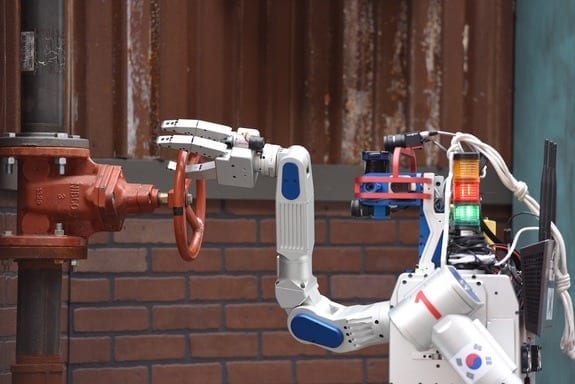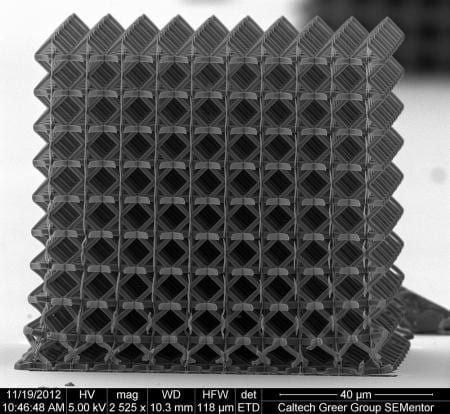
Researchers from Leeds and Bradford are working with colleagues from the United States to develop an exciting new robotic device that helps children to practice and improve their manual (hand) coordination.
The findings of a pilot study are being presented today, 5th September 2013 at the British Psychological Society’s Annual Conference in Reading, detailing the first time this innovative new technology has been trialled in a UK school.
The collaboration involves Professor Mark Mon-Williams, Dr. Liam Hill from the University of Leeds, Katy Shires from the Bradford Institute of Health Research and Professor Geoffrey Bingham’s lab from the University of Indiana (USA). This team has been working on creating a haptic robotic training system that gives children feedback and scaffolds their performance as they practice hand and wrist movements commonly made during handwriting and other manual tasks.
The device has already been tested in a study in the United States, results showing that the increased feedback it provides particularly aids children who have underlying movement problems, providing them with the extra support they need whilst trying to learn everyday tasks they typically have great difficulty with (e.g. handwriting, using cutlery and dressing themselves).
How does it work? A child holds a pen connected to the cradle of a small robotic arm (circled in red). They then move the pen around in order to play ‘computer games’ presented on the screen of the computer (circled in blue). The games the children play require them to practice hand and wrist movements commonly made during handwriting (and other manual tasks). As the child plays the games the robot’s arm (purple arrow) helps them learn the correct movements by pushing and pulling the pen in the direction required to make the right moves. The strength to which the arm pushes/pulls towards the correct movement can be varied so that as the child becomes more confident the arm can reduce its level of support, allowing the child to increasingly do the task on their own.
What are we doing?Recently we have just completed the first UK pilot study using this robotic device, demonstrating its feasibility for use (i) in the classroom and (ii) with children of a younger age than previously studied. Working with a small number of five to seven year old children in a primary school in Bradford, who had a wide range of manual abilities, we investigated their level of motivation and enjoyment whilst practicing for 20 minutes on a variety of robotic arm tasks presented previously in US-based studies using the system. We also trialed simpler versions of these tasks, which were expected to be more age appropriate for the younger children we were working with.
All the children found the tasks highly enjoyable and were able to perform them to an acceptable level. Differences in performance between children previously identified by their classroom teachers as having handwriting difficulties were also noticeable (e.g. taking longer to complete, making more errors if the level of support the robotic arm provided was reduced). Plans are now underway to run a larger intervention study within schools in Bradford that will formally investigate whether the findings from the US can be replicated in younger school children here in the UK (i.e. will the system help them improve their handwriting and manual-dexterity development?).
The Latest Bing News on:
Robotic therapy
- AI robot graduation speaker is not A-OK for some students at D'Youvilleon April 26, 2024 at 11:46 am
D'Youville has invited Sophia, a humanoid automaton produced by Hong Kong-based Hanson Robotics, to address its graduates at the May 11 ceremony at LECOM Harborcenter. And that is a problem for scores ...
- Health Headlines: Robot therapy dogs bringing smiles to children’s faceson April 26, 2024 at 9:52 am
STANFORD, Calif. (Ivanhoe Newswire) - A recent peer-reviewed study indicates that children who spend time with therapy dogs can lower their stress even more than relaxation exercises. That outcome ...
- Robot Speaker at Commencement? Some Human Students Balkon April 26, 2024 at 12:48 am
Enter Sophia, a humanoid robot first launched in 2016 from Houston-based Hansen Robotics. The Buffalo university announced Wednesday it would bring Sophia to speak at its May 11 commencement ceremony.
- Health Spotlight: Robotic puppies are therapeuticon April 25, 2024 at 12:08 pm
A peer reviewed study indicates that children who spend time with therapy dogs can lower their stress even more than relaxation exercises.
- Multiply Labs and GenScript Biotech Corporation Collaborate to Automate the Cell Isolation and Enrichment Phase of Cell Therapy Manufacturingon April 25, 2024 at 6:00 am
Multiply Labs, a robotics company developing industry-leading automated manufacturing systems to produce individualized drugs, and GenScript Biotech Corporation (GenScript), one of the world's leading ...
- 2 colleges to partner with PT group on new specialty centeron April 24, 2024 at 3:00 am
Daemen University will partner with Villa Maria College and Buffalo Rehab Group to develop its Institute for Mobility Innovation & Technology, with plans to site the center on the Villa campus in ...
- Pioneering prostate treatment: The Yorkshire Clinic is first in the north to offer ‘game changing’ therapyon April 24, 2024 at 12:39 am
The misery of an enlarged prostate and fears over potential side effects of some treatments could be over with this pioneering new procedure.
- Health Beat: Robotic puppies and the therapeutic benefitson April 18, 2024 at 1:00 pm
Therapy animals have long been known to help reduce pain, anxiety, and depression, and doctors say the robotic dogs are already showing some of the same benefits.
- Robotic Puppies Are Therapeutic Also!on April 15, 2024 at 2:35 pm
The robotic dogs known as Max, Otis, and Stride are Stanford’s way to curb the anxiety being felt by their young patients.
- Robotic Radiotherapy Market Worth $1.9 billion | MarketsandMarketson April 15, 2024 at 7:31 am
Robotic Radiotherapy Market in terms of revenue was estimated to be worth $1.1 billion in 2023 and is poised to reach $1.9 billion by 2028, growing at ...
The Latest Google Headlines on:
Robotic therapy
[google_news title=”” keyword=”Robotic therapy” num_posts=”10″ blurb_length=”0″ show_thumb=”left”]
The Latest Bing News on:
Haptic robotic training system
- Sanctuary AI’s latest Phoenix humanoid can learn tasks in 24 hourson April 25, 2024 at 10:37 am
The latest version of Phoenix, and its AI control system Carbon, draw even closer to human-like capabilities, Sanctuary AI says.
- Old Dominion University, HaptX, and Georgia Tech Win Grant Award for Project to Advance VR for Vision-Impairedon April 23, 2024 at 6:50 am
Co-principal investigators Dr. Michel Audette, PhD, Associate Professor, Department of Electrical and Computer Engineering at ODU Batten College of Engineering and Technology, and HaptX Director of ...
- Novel robotic training program reduces physician errors placing central lineson April 17, 2024 at 2:08 pm
More than five million central lines are placed in patients who need prolonged drug delivery, such as those undergoing cancer treatments, in the United States every year, yet the common procedure can ...
- This smart glove can teach you to master new skillson February 28, 2024 at 4:43 am
The feedback can take a variety of forms, such as sound signals or visual displays, or even vibrations via haptic feedback. This enables the user to learn new physical gestures and master new skills, ...
The Latest Google Headlines on:
Haptic robotic training system
[google_news title=”” keyword=”haptic robotic training system” num_posts=”10″ blurb_length=”0″ show_thumb=”left”]










